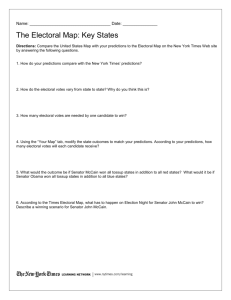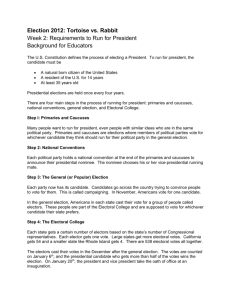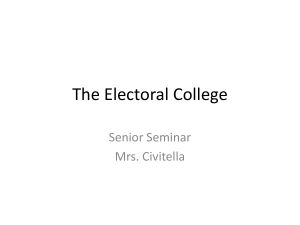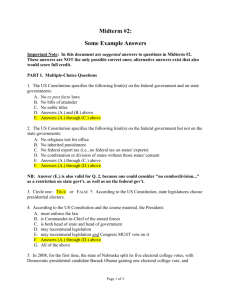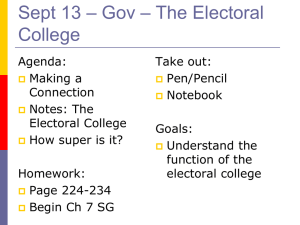Electoral College 101 reading and questions
advertisement
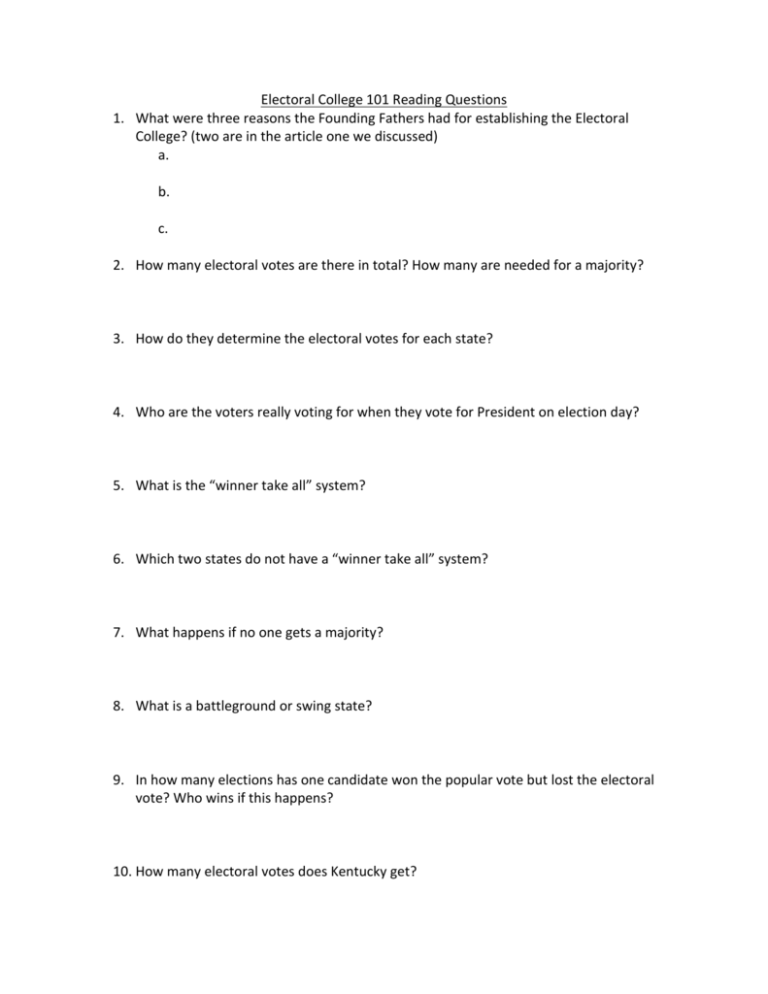
Electoral College 101 Reading Questions 1. What were three reasons the Founding Fathers had for establishing the Electoral College? (two are in the article one we discussed) a. b. c. 2. How many electoral votes are there in total? How many are needed for a majority? 3. How do they determine the electoral votes for each state? 4. Who are the voters really voting for when they vote for President on election day? 5. What is the “winner take all” system? 6. Which two states do not have a “winner take all” system? 7. What happens if no one gets a majority? 8. What is a battleground or swing state? 9. In how many elections has one candidate won the popular vote but lost the electoral vote? Who wins if this happens? 10. How many electoral votes does Kentucky get? ELECTORAL COLLEGE 101 Don't understand the Electoral College? You're not alone. Here's a guide to how it works. What exactly is the Electoral College? This college doesn't have fraternities, a football team, or cheerleaders: It's just 538 people from all 50 states and Washington, D.C., called electors. According to the Constitution, they are responsible for electing the President and Vice President. The winner needs a majority — 270 — of the 538 electoral votes. How did this system come about? In 1787, when the Constitution was being drafted, the Founding Fathers didn't want the President and Vice President to be chosen directly by the people, or by Congress. To establish a role for the states in national elections—consistent with their idea of a federalist system of government—and to protect the country from what they saw as an ill-informed populace, they devised the system that came to be known as the Electoral College. They envisioned it as an elite group of men (there wasn't a female elector until 1912) who could be trusted with choosing the nation's leaders. The system was also supposed to ensure that a candidate with overwhelming support in only one part of the country—which might enable him to win a slim majority of the popular vote nationally—would not be elected President against the will of the rest of the nation. In some states, the legislatures chose the electors; in others, electors were chosen by popular vote. The system has changed little in more than 200 years, except that now each state's political parties nominate slates of electors who are pledged to support their party's candidates. How many electoral votes does each state get? The same number as its delegation in Congress: however many seats it has in the House of Representatives (which is based on population) and the Senate (always 2). For example, Colorado has 7 Representatives and 2 Senators, so it gets 9 electoral votes. (Territories like Guam and Puerto Rico don't get votes.) If these 538 electors choose the President, then what's Election Day about? Technically, Americans won't be voting for John McCain and Sarah Palin or Barack Obama and Joe Biden (even though their names appear on the ballot) but for a slate of electors from their state who have pledged to support Obama or McCain and their running mates. So how does a candidate win? Each state's electoral votes are awarded on a winner-take-all basis (except in Maine and Nebraska). The candidate with the most popular votes in a state— whether the margin of victory is 3 votes or 3 million—gets all of that state's electoral votes. Do electors actually cast their votes? It's usually a formality, but in December, the electors representing the candidate who won their state's popular vote meet in their state capital and cast their votes. The results of the national election become official when the states' electoral ballots are counted before a joint session of Congress on January 6. The winners are sworn in on Inauguration Day, which is always January 20. What if no candidate gets a 270-vote majority? The House elects the President (each state gets one vote), and the Senate elects the Vice President, with each Senator getting one vote.* Can one candidate win the popular vote and another win the electoral vote? Yes, and the electoral vote determines who will be President. It happened most recently in 2000, when Al Gore won the popular vote but George W. Bush won the electoral vote and the White House. It's happened only three other times: in 1824, 1876, and 1888. It sounds like a complicated system The trick is to think about the election the way the candidates do: not as a single contest, but as 51 separate elections. They have to figure out how to win enough of those 51 contests to rack up 270 electoral votes. How is this playing out in 2008? Obama and McCain aren't spending much time, or TV ad dollars, in states where they're way behind or way ahead. Instead, they're targeting "battleground" or "swing" states that look close. According to analyses by The New York Times and other news organizations, eight states (shown in yellow above) were still up for grabs in mid-October. (For a current version of the Times map, go to the 2008 Campaign section of nytimes.com.) So if you live in California or Texas, you're probably not seeing as many campaign ads on TV as people in Florida or Ohio. In those and other battleground states it may seem as though McCain and Obama have taken over your TV set. *The Senate has exercised this power only once. In 1837, Martin Van Buren was elected President, but Richard M. Johnson fell one electoral vote short of a majority among four vice presidential candidates. The Senate elected Johnson Vice President by a vote of 33 to 16.


